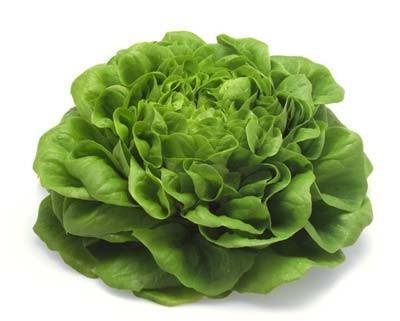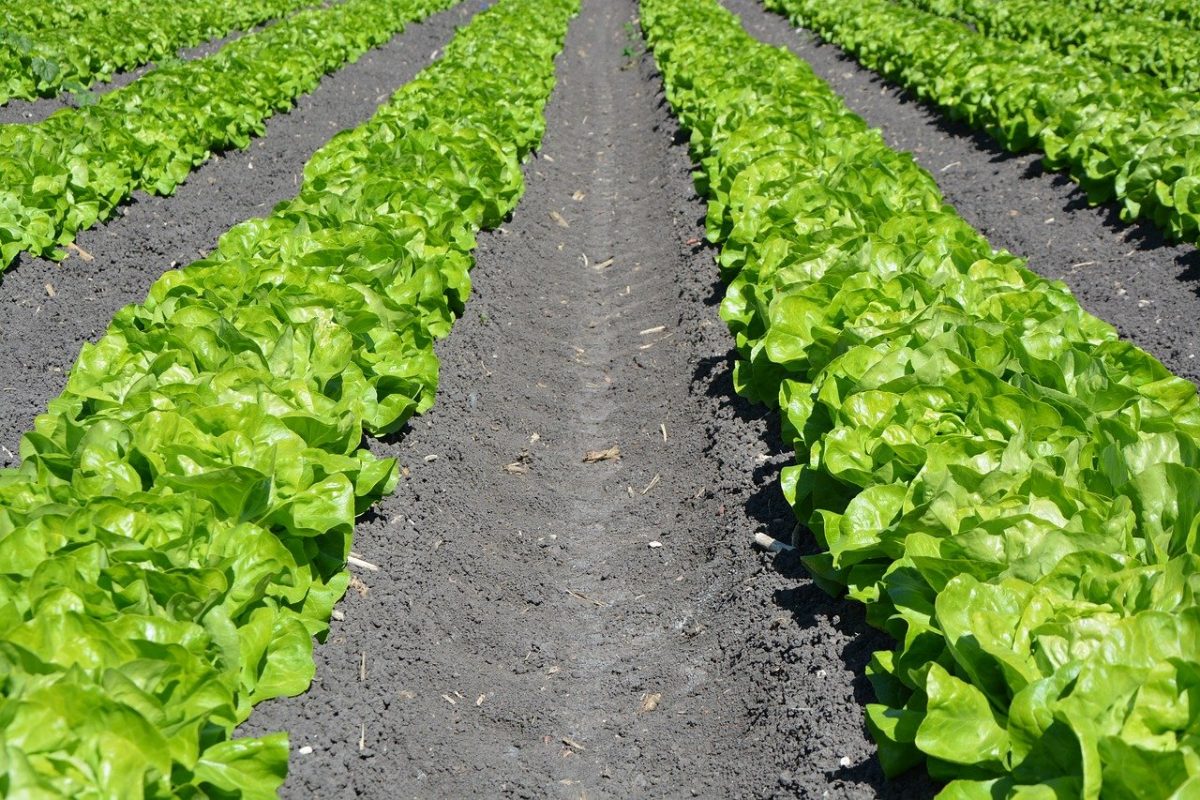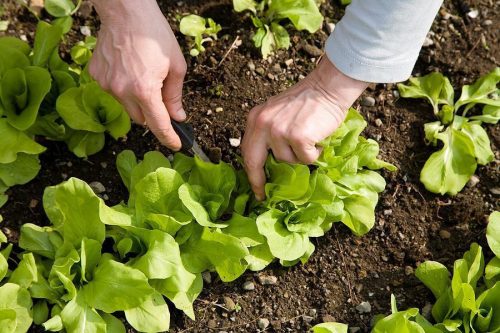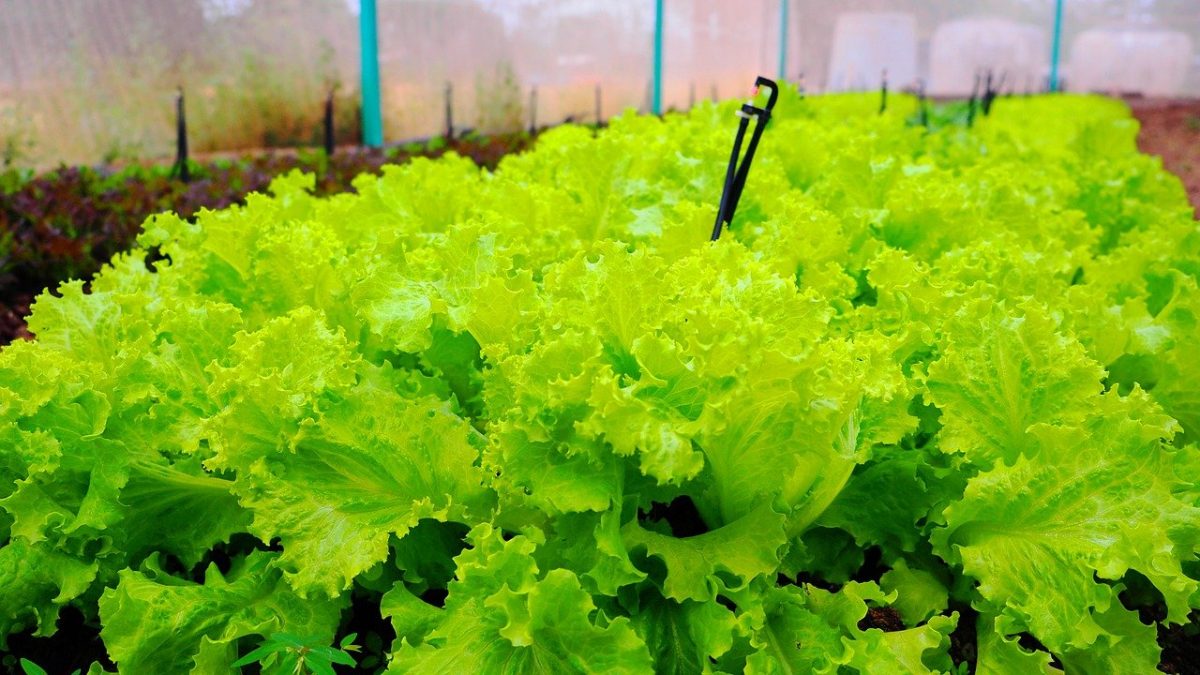Lettuce, information about crop management
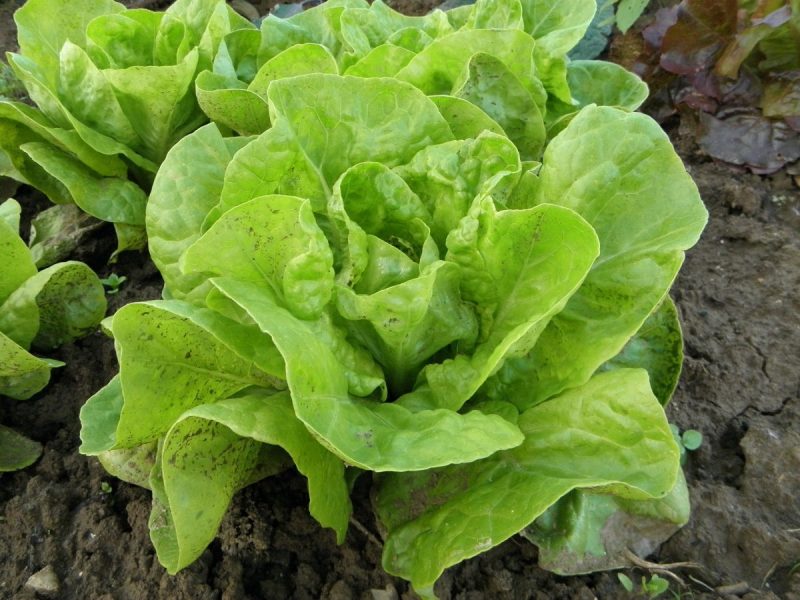
Lettuce (Lactuca sativa) is cultivated for its leaves, which are consumed fresh, having rich content of vitamins and minerals. Lettuce is best grown in spring and autumn. This ensures the consumption of fresh vegetables during this period. It can also be grown successfully in winter if the temperature conditions are right, and in summer, when hybrids are used for growth during this period.
The plant is native to Russia, Central, and Southern Europe, and is currently cultivated in all countries. The great diversity of varieties, shapes, and colors makes lettuce a basic ingredient in salad recipes.
The root is pivoting, with numerous lateral branches. Leaves are characteristic in shape and color according to the variety or hybrid grown, short petiolate, with smooth or toothed margins. The floral stem appears 50-60 days after sowing, is branched, and bears a head-like capitulum. The fruit is an achene, of different colors.
Climate and soil requirements
Lettuce is not pretentious about the temperature during the germination phase, 2-3 ℃ being enough for the plants to sprout.
Also, young plants with 4-5 leaves are hardy and can withstand negative temperatures, as lettuce overwinters in the rosette stage. The optimum growth and development temperature for this species is 16℃. Light requirements are low for lettuce. It can be grown in seasons with lower light radiation or as a companion plant with other species (radish, green onions, etc.). It prefers humus-rich, well-drained soils with good water-holding capacity. Grows well in soil with a slightly acidic or neutral pH.
Cultivation
Crop rotation
The best lettuce yields are obtained from crops that are fertilized with organic matter and that leave the soil free of weeds. Due to its short growing season, it can be grown in a successive crop system, before or after a basic crop (tomatoes, aubergines, peppers, cucumbers). It can also be grown with green onions, radishes, green garlic, green onions, etc.
Soil preparation
It can be done in autumn or winter windows, depending on when the crop is established. Organic and chemical fertilizers can be applied before plowing. Before establishing the crop by sowing or planting seedlings, the land must be tilled. In addition, a pre-emergent herbicide can be applied if the soil is infested with weed seeds.
Recommended products
-
You can find products on a different store
Change Store -
You can find products on a different store
Change Store -
You can find products on a different store
Change Store -
You can find products on a different store
Change Store -
You can find products on a different store
Change Store -
You can find products on a different store
Change Store -
You can find products on a different store
Change Store -
You can find products on a different store
Change Store -
You can find products on a different store
Change Store -
You can find products on a different store
Change Store -
You can find products on a different store
Change Store -
You can find products on a different store
Change Store -
You can find products on a different store
Change Store -
You can find products on a different store
Change Store -
You can find products on a different store
Change Store -
You can find products on a different store
Change Store -
You can find products on a different store
Change Store -
You can find products on a different store
Change Store -
You can find products on a different store
Change Store -
You can find products on a different store
Change Store -
You can find products on a different store
Change Store -
You can find products on a different store
Change Store -
You can find products on a different store
Change Store -
You can find products on a different store
Change Store
Crop establishment
The lettuce crop is established by planting seedlings or sowing seeds. For direct sowing, the soil must be thoroughly tilled and the soil moisture must be kept constant for uniform germination. The soil temperature, in this case, must be above 3 ℃. The seedling can be produced in warm hotbeds, polyhouses, or greenhouses. When the plants have 2-3 well-developed real leaves, they can be transplanted into pots or alveolar trays, where they are kept until planting. The seedlings can be fertilized with rooting stimulators.
Recommended products
-
You can find products on a different store
Change Store -
You can find products on a different store
Change Store -
You can find products on a different store
Change Store -
You can find products on a different store
Change Store -
You can find products on a different store
Change Store -
You can find products on a different store
Change Store -
You can find products on a different store
Change Store -
You can find products on a different store
Change Store -
You can find products on a different store
Change Store -
You can find products on a different store
Change Store -
You can find products on a different store
Change Store -
You can find products on a different store
Change Store -
You can find products on a different store
Change Store -
You can find products on a different store
Change Store -
You can find products on a different store
Change Store -
You can find products on a different store
Change Store -
You can find products on a different store
Change Store -
You can find products on a different store
Change Store -
You can find products on a different store
Change Store -
You can find products on a different store
Change Store -
You can find products on a different store
Change Store -
You can find products on a different store
Change Store -
You can find products on a different store
Change Store -
You can find products on a different store
Change Store
To extend the harvest period, sowing can be done in stages. The seedlings are planted in the field when they are 25-30 days old and have 4-5 true leaves, and the climatic conditions are optimal. Before planting, the seedlings should be well watered to hydrate them properly.
For planting, distances of 30 cm between rows and 25-30 cm between plants per row can be used, depending on the variety. Lettuce can be grown throughout the year if varieties are used according to the season and environmental conditions.
After planting, irrigation can be applied, and at the same time, you can also use fertilizers to stimulate rooting. At the next irrigation, fertilizer can be applied to improve fertility and soil structure and to create better root absorption conditions.
Recommended products
-
You can find products on a different store
Change Store -
You can find products on a different store
Change Store -
You can find products on a different store
Change Store -
You can find products on a different store
Change Store -
You can find products on a different store
Change Store -
You can find products on a different store
Change Store -
You can find products on a different store
Change Store -
You can find products on a different store
Change Store -
You can find products on a different store
Change Store -
You can find products on a different store
Change Store -
You can find products on a different store
Change Store -
You can find products on a different store
Change Store -
You can find products on a different store
Change Store -
You can find products on a different store
Change Store -
You can find products on a different store
Change Store -
You can find products on a different store
Change Store -
You can find products on a different store
Change Store -
You can find products on a different store
Change Store -
You can find products on a different store
Change Store -
You can find products on a different store
Change Store -
You can find products on a different store
Change Store -
You can find products on a different store
Change Store -
You can find products on a different store
Change Store -
You can find products on a different store
Change Store
Pest and disease control
It is done by applying treatments with approved fungicides or insecticides. To avoid the appearance of diseases or pests resistant to pesticides, it is recommended to alternate products.
Weed control
To control weeds and maintain higher soil temperatures, plants can be mulched with polythene foil to ensure constant soil moisture.
Irrigation
It is carried out as often as necessary, depending on environmental factors and cultivation technology, so that the plants benefit from moderate but constant amounts of water. Drip irrigation is the most recommended method of water management for lettuce.
Fertilization
It can be done through the irrigation system, with balanced fertilizers in the early stages of growth. After the plants start to form heads, specific fertilizers can be applied.
Recommended products
-
You can find products on a different store
Change Store -
You can find products on a different store
Change Store -
You can find products on a different store
Change Store -
You can find products on a different store
Change Store -
You can find products on a different store
Change Store -
You can find products on a different store
Change Store -
You can find products on a different store
Change Store -
You can find products on a different store
Change Store -
You can find products on a different store
Change Store -
You can find products on a different store
Change Store -
You can find products on a different store
Change Store -
You can find products on a different store
Change Store -
You can find products on a different store
Change Store -
You can find products on a different store
Change Store -
You can find products on a different store
Change Store -
You can find products on a different store
Change Store -
You can find products on a different store
Change Store -
You can find products on a different store
Change Store -
You can find products on a different store
Change Store -
You can find products on a different store
Change Store -
You can find products on a different store
Change Store -
You can find products on a different store
Change Store -
You can find products on a different store
Change Store -
You can find products on a different store
Change Store
To help plants overcome periods of stress, foliar and root fertilization can be carried out with specific fertilizers. Root fertilizers can be applied to improve soil structure and root absorption.
Harvesting
Lettuce is harvested by cutting off the heads when they have reached the desired size, in cool dry weather. Harvesting can also be done mechanically. After harvesting, remove damaged, or dried leaves. The heads can be stored in cool places and can be kept for up to 10-12 days in controlled atmosphere storage.
Particularities of growing lettuce in protected areas
The crop establishment is done exclusively through seedlings, produced in spaces intended for this purpose. It can be done at any time of the year. The difference is that in greenhouses and polyhouses, the plants have optimal conditions for growing longer during the cold period. In this case, varieties and hybrids are chosen for cultivation in the desired season.
The work of establishing and caring for culture is similar to that of field culture. In protected areas, to make the space more efficient, depending on the cultivated variety, the planting distances can be reduced (25 × 25 cm).














































































































































































































































































































































































































































